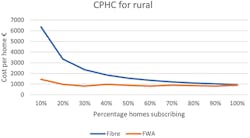Gigabit Broadband Deployments Requires Hybrid Strategies
Politicians and others have rightly argued for high-speed broadband access for all. Those without it are excluded from aspects of society, which has been especially prominent during the Covid-19 isolation period. In general, a home broadband speed of 100Mbits/s or more enables unconstrained access to the digital world. Anything less results in slower services, and below 10Mbits/s some applications, such as gaming and high-definition video, may not be possible.
The challenge of delivering higher speeds — often with an aspiration to get to a gigabit per second — is purely economic. After all, if electricity can be provided to a home, then so can fiber optic cables. However, for homes outside of urban areas, the cost of delivering high-speed broadband may be higher than the amount operators can afford, or are willing, to pay. There are 2 solutions to this, often working in parallel. One is to reduce the cost of provisioning; the other is for the Government to provide subsidy.
Costs of Provisioning
The gold standard for home broadband is often seen as fiber cable direct to the home (FTTH). Fiber has a virtually unlimited bandwidth, and so once installed is future-proof against any increase in demand that might occur. Fiber deployment is well understood, and metrics to measure it, such as cost per home passed, are used as benchmarks.
Fiber costs are relatively simple: the cost is dominated by the installation of the fiber (digging), which is often measured on a per mile or meter basis. A fiber cable is installed along a street, with the cost per home passed being the distance between homes multiplied by the cost per metre. Once a home subscribes to the service then there is a further cost of extending the fiber from the road to the house, which is again distance multiplied by cost per meter.
So, for example, for homes spaced 10 meters apart, the cost per home passed (CPHP) might be $300 if the cost per meter of digging was $30. If homes were spaced 5 metres back from the road, then the cost of connection might be $150 digging, plus perhaps $50 for installing a connection in the home. The cost per home connected (CPHC) then depends on the percentage of homes that take the service. For example, if 33% take the service, the distance between homes taking the service is 30 meters, and so the overall cost is $900 to pass the home and $200 to connect, making $1,100.
The key parameters for fiber are the cost of digging, the distance between homes, and the subscription rate. As areas become more rural, the distance between homes will extend significantly. As well as this, more backhaul is needed between rural communities and this can start to become a significant component of the overall cost. More digging takes additional time as well, slowing deployment. So, while fiber is an excellent solution, it may be uneconomic and take too long to deploy outside of urban areas.
Fixed Wireless Benefits
Fixed wireless access (FWA) involves a base station in the locality and customer premise equipment (CPE), which are typically small boxes mounted on the outside wall of the home. The economics of FWA are completely different, so much so that an apples-to-apples comparison using CPHP do not apply. Simply deploying a base station (or BTS) that covers an area could be considered to "pass" the home, meaning that thousands of homes could be passed for a cost of, perhaps, $30,000.
The connection cost involves deploying a CPE, which might cost $370 and $130 for installation, totalling $500. As more CPEs are deployed within the coverage of a BTS, the capacity of the BTS may be exceeded, and more would need to be built to meet the demand.
That said, FWA is far less dependent on distance between homes and subscription rate. The major cost is connecting the home, and this is only incurred once the home subscribes. This is known as a success-based OpEx. Intuitively, FWA is increasingly advantageous compared to fiber when homes are more widely spaced and when the subscription rate is lower.
However, the capacity of fiber is effectively infinite, as each home has its own strand of fiber which can deliver a continuous 10Gbits/s data stream. As more homes subscribe or data usage per home grows, there is no need to upgrade the network. FWA has a finite capacity, shared among all subscriber using a BTS. As the number of subscribers or usage grows, then the BTS may need upgrading or splitting into multiple BTSs. In this way, fiber has an advantage where capacity requirements are high.
Fiber also has an advantage in OpEx: a buried cable needs no attention. However, FWA systems require periodic replacement as the electronics deteriorates or become obsolete. This is often required on a 10-year cycle.
Overall, fiber has a high up-front cost as cable is laid. That cost grows as subscribers become more rural. There is a risk that if fewer homes than expected take the service, since there is no way to recover costs. But once installed, there is little need for additional OpEx.
FWA has a low up-front cost which is very minimally affected by rural deployments. It also is not impacted if fewer homes take the service. Yet FWA needs on-going OpEx to expand capacity and OpEx to maintain the network.
CPHP vs CPHP
It is not possible to generically compare CPHP or CPHC for FWA and fiber. These metrics make sense only for a specific deployment where many factors, such as distance between homes, percentage take-rate for the service, typical home usage, and FWA spectrum holdings, are specified. Otherwise, comparisons are of very little use or value.
For example, Figure 1 shows the cost per home connected versus percentage subscribing for a generic rural deployment. This shows how FWA is relatively insensitive to the subscription rate, whereas fiber is very sensitive, especially at low rates.
Subsidies
Regardless of whether fiber or FWA is to be used, the argument can be made that subsidies are needed in rural areas. (If they were not needed then the broadband service would already have been deployed).
Subsidies such as the Rural Digital Opportunity Fund (RDOF) in the US and the Gigabit Voucher Scheme in the UK are currently being provided. The terms associated with these, however, can have a strong influence on the means of provisioning gigabit broadband.
For example, both strategies require the ability to deliver 1Gbits/s or more (which defines gigabit connectivity). They are also time-limited, creating a need to move quickly. While the funds often have fiber in mind, the shortened timescales can often make fiber deployment unachievable because digging is inherently a slow process. In this case, the only alternative that can deliver gigabit connectivity is FWA. Other solutions, such as mobile and satellite, cannot reliably deliver these data rates.
Delivering Connectivity
Broadband for all is proving difficult due to the provision of broadband outside of urban areas being uneconomic in many cases. Both elements of demand subsidy and require rapid gigabit deployments. This is where the hybrid options must be considered. Where fiber will continue to be the main workhorse for broadband access, relatively rapid deployment and FWA can be deployed quicker than fiber. Therefore, network service providers and governments must consider both options for the future.
For more information, please email [email protected], visit https://www.cbng.co.uk/, and follow on Twitter @CBNGTeam and LinkedIn.






